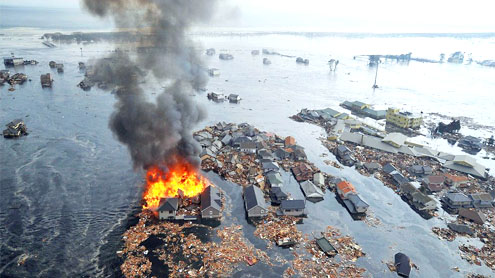 The malevolent earthquake and tsunami in Japan have jolted our minds back to the 2004 catastrophe in the Indian Ocean, as well as to last year’s tsunamis in Chile and Sumatra.Gruesome comparisons are inevitable, as is the fatalism that follows such “acts of God.” What can man do in the face of nature’s wrath? Not everything, of course — and a natural disaster is always a most sobering reminder of our own limitations. But it is clear — and painfully so — that the international community has not done a fraction of what it had hoped to do in the aftermath of the carnage in 2004, when the devastation in Banda Aceh, Phuket, Sri Lanka, and parts of Africa led to a global resolve to be better prepared for the next time.
The malevolent earthquake and tsunami in Japan have jolted our minds back to the 2004 catastrophe in the Indian Ocean, as well as to last year’s tsunamis in Chile and Sumatra.Gruesome comparisons are inevitable, as is the fatalism that follows such “acts of God.” What can man do in the face of nature’s wrath? Not everything, of course — and a natural disaster is always a most sobering reminder of our own limitations. But it is clear — and painfully so — that the international community has not done a fraction of what it had hoped to do in the aftermath of the carnage in 2004, when the devastation in Banda Aceh, Phuket, Sri Lanka, and parts of Africa led to a global resolve to be better prepared for the next time.
The three tsunamis in the past 13 months — including the havoc in Japan — have devastated nearby coastlines. In Chile in February 2010, people did evacuate, but mostly of their own accord. A tsunami warning was issued, and then mysteriously lifted, at the same time as the tsunami was climbing up the rugged Chilean coastline. More than 200 died. In Sumatra in October, nature and man worked against the victims; most people didn’t feel the earthquake strongly enough to trigger self-evacuation, and the tremor struck at night. A crawl line appearing on all TV channels in Sumatra asking them to evacuate was not seen by people in the Mentawai Islands off Sumatra’s western coast because most villages there have no electricity. Their first intimation of the incoming wave was its roaring sound just offshore. More than 400 drowned. Sirens did ring in Japan — this is, after all, one of the most civic-minded countries on earth — yet hundreds, if not thousands, died.
What went wrong again? As far as preparedness is concerned, the main reason is that we continue to be focused on past disasters, rather than on building tsunami-resilient communities around the globe. We deploy sensors to warn us of where older tsunamis struck, but we are not doing enough to anticipate future events. While more than 40 tsunamographs — the special instruments in the deep ocean developed by the United States’ National Oceanic and Atmospheric Administration — are now measuring tsunami heights around the Pacific adjacent to the US, people in French Polynesia and other Pacific Islands have to wait and wait, without knowing what is about to hit them. And even in Japan, arguably the most tsunami-ready nation in the world, there are no tsunamographs to provide notification when it is safe for search-and-rescue operations to begin.This is not an easy matter. Tsunami floods can move at speeds exceeding 15mph. People who don’t evacuate on time may be fighting for their lives while perched on trees or moving logs, and rescuers have little information on whether it is safe to move in immediately and rescue them or whether the next wave will be even bigger. People who do evacuate may be drawn back to their homes by the lull between wave arrivals, only to be swept away by the next one. As opposed to earthquakes that last, at worst, a few minutes, tsunamis can flood coastlines for several hours, particularly inside closed bays or harbours. Even when people start evacuating immediately, they may not have time to reach high ground if the nearest hill is a few miles away.
What is alarming is how little has changed around the world in terms of an awareness of the simpler protective steps to take. During the Samoan tsunami in September 2009, people who could easily have climbed to high ground in the hills behind them chose, instead, to evacuate by car. Many drowned in their cars, which were struck in exodus traffic along narrow coastal roads. When the 2010 Chilean tsunami arrived in California, people in Santa Monica Beach were mesmerised by the rapid withdrawal of the shoreline and went out to gawk at stranded marine life. It is a miracle that the tsunami was small and they were able to get away.Tsunamographs need to be deployed around the world, supplemented by inundation maps. These are maps that show the extent of possible tsunami flooding from hypothetical earthquakes in their vicinity. Even in the US, only California has completed its mapping efforts. Alaska and Hawaii, the most vulnerable US states, do not have modern tsunami flood maps for all their coastal communities. While there are now regional warning centers in the Indian Ocean, there are none in the Mediterranean. A huge plate boundary almost as long as the one off Sumatra lurks in the eastern part of the basin and has produced earthquakes and tsunamis of similar magnitude as Friday’s event off Japan a few times in the past 2,000 years.
Yet intercountry politics on setting jurisdictional boundaries, the illusions of national warning centers with futuristic control rooms, tens of millions of dollars in funding, and a very predictable denial of the hazard have resulted in a tsunami of inaction. By serendipity, the same day the Japanese tsunami hit, European nations were gathered in UNESCO’s headquarters in Paris to discuss — for the seventh time since 2005 — the logistics of creating a warning system in the Mediterranean Sea. The European Union could have a world-class warning system tomorrow if it could swallow its pride and pipe dreams and ask the NOAA’s Pacific Tsunami Warning Centre, which now covers the Pacific and Indian oceans and the Caribbean Sea, for coverage. The PTWC is not perfect, but it is the best we’ve got.However, a world-class warning system is only part of the tsunami story. What the world needs are tsunami-resilient communities that plan ahead not for any particular tsunami but for a medley of coastal hazards, storm floods, sea-level rises, and hurricanes. Evacuation drills and continuous education are keys to long-term survival. Every time we fly, we are reminded to put on our seat belts and of how to use life vests. We need to be reminded, every time we visit any coastline around the world, of the possibility of a tsunami and of the simple steps we ought to follow to save ourselves. And to exemplify the principle, if you are close to the coast and see any unusual shoreline motions, or feel any tremor that lasts more than 30 seconds, evacuate inland or to high ground. – Khaleejtimes











